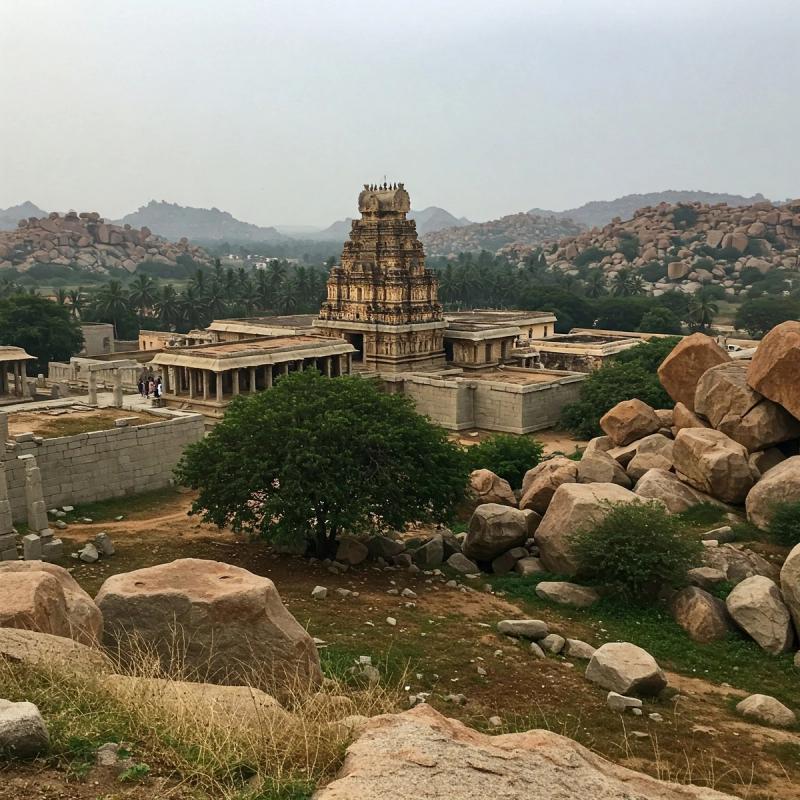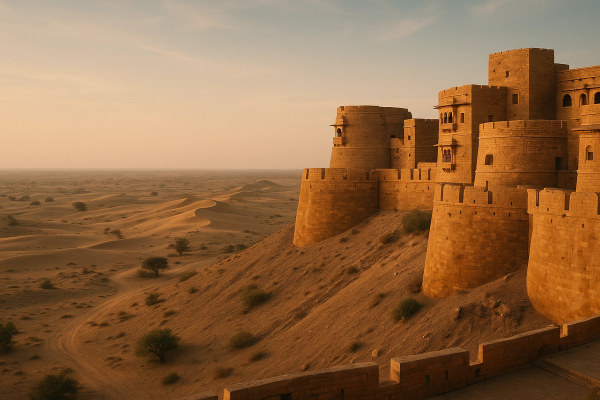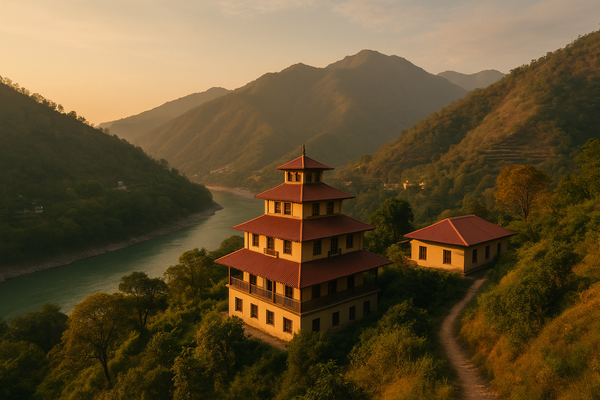
Hampi on a Shoestring: Your Ultimate Budget Backpacking Guide to Ancient Ruins, Boulders, and Riverside Vibes#
Imagine stepping into a landscape ripped from a fantasy novel: giant, ochre-toned boulders tumbled across hills, emerald paddy fields hugging a languid river, and magnificent ancient ruins whispering tales of a glorious empire. This isn't fiction; it's Hampi. Tucked away in Karnataka, South India, this UNESCO World Heritage site is more than just a historical marvel; it's a backpacker's dream. If you're seeking adventure, history, spirituality, and a chilled-out vibe without emptying your wallet, then this Hampi budget backpacking guide india is your starting point. Get ready to explore crumbling temples, climb world-class boulders, sip chai by the river, and discover why Hampi captures the hearts of travelers from across the globe.¶
Why Hampi? A Glimpse into a Lost Empire#
Hampi was once the magnificent capital of the Vijayanagara Empire, one of the largest Hindu empires in Indian history. In its 14th-16th century heyday, it was a thriving metropolis, famed for its wealth, architecture, and vibrant culture. What remains today is a sprawling open-air museum spread over 40 square kilometers, dotted with over 1,600 surviving structures – temples, palaces, marketplaces, fortifications, and royal enclosures. The sheer scale is breathtaking.¶
But Hampi isn't just about the past. The dramatic, boulder-strewn landscape, shaped by millions of years of geology, attracts rock climbers and adventurers. The serene Tungabhadra River bisects the area, creating lush pockets of green and offering tranquil spots for relaxation. It's this unique blend of profound history, raw natural beauty, and a relaxed, almost bohemian atmosphere that makes backpacking through Hampi an unforgettable India travel experience.¶
Best Time to Visit Hampi: Timing Your Trip#
Choosing the right time to visit Hampi can significantly impact your experience, especially when traveling on a budget.¶
Peak Season: October to February (Winter)#
This is widely considered the best time. The weather is pleasant, with warm sunny days (perfect for exploring ruins and climbing) and cool evenings. Daytime temperatures usually hover between 25°C and 30°C (77°F - 86°F). It's ideal for sightseeing without melting.¶
- Pro: Comfortable weather for all activities.
- Pro: Clear skies, great for photography.
- Con: This is peak tourist season, so expect larger crowds at major sites like Virupaksha and Vittala Temples.
- Con: Accommodation prices can be slightly higher, so book your cheap stays Hampi in advance.
Shoulder Season: March to May (Summer) & June to September (Monsoon)#
Summer (March-May) gets scorching hot, with temperatures easily exceeding 40°C (104°F). Exploring during the day becomes challenging. However, if you can handle the heat (think very early mornings and late afternoons for activities), you'll find fewer crowds and potentially lower prices.¶
Monsoon (June-September) brings relief from the heat but also rain. While the landscape turns incredibly lush and green, heavy downpours can disrupt travel plans. River levels rise, potentially affecting coracle rides and crossings. Bouldering might be difficult due to wet rock. It's the least crowded time, offering a very different, atmospheric perspective of Hampi.¶
My Tip: For the best balance of good weather and manageable crowds, aim for late October/early November or late February. You still get pleasant temperatures but might avoid the absolute peak rush.
Getting There & Around Hampi on a Budget#
Reaching Hampi is part of the adventure, and thankfully, it's quite accessible for budget travelers.¶
Reaching Hampi#
- By Train: The most popular and budget-friendly option. The nearest major railway station is Hospet Junction (Hosapete - HPT), about 13 km from Hampi. Hospet is well-connected by overnight trains from major cities like Bangalore, Hyderabad, Goa (Vasco da Gama), and Mumbai. From Hospet station, you can take a local bus (very cheap, around ₹20-30) or an auto-rickshaw (negotiate hard, aim for ₹250-400) to Hampi Bazaar.
- By Bus: Overnight sleeper buses (both government and private) connect Hospet to Bangalore, Goa, Hyderabad, Mumbai, and other cities. These offer a comfortable and affordable way to travel, often costing between ₹600-1200 depending on the route and bus type (AC/non-AC sleeper). KSRTC (Karnataka State Road Transport Corporation) offers reliable services.
- By Air: The nearest airports are Hubli (HBX, approx. 160 km away) and Bellary (BEP, approx. 60 km away), but flight connectivity is limited. Vidyanagar Airport (VDY) near Toranagallu is closer (around 40km) but has even fewer flights. Bangalore (BLR) remains the major international gateway, from where you can take an overnight train or bus.
Getting Around Hampi#
Hampi's sights are spread out, so you'll need transport. Luckily, there are several budget-friendly ways to explore:¶
- On Foot: Many key ruins around the Hampi Bazaar area and Hemakuta Hill are easily walkable. Perfect for soaking in the atmosphere.
- Bicycle: Renting a bicycle (around ₹100-150 per day) is a fantastic way to explore the main temple complexes and surroundings at your own pace. Roads are generally quiet, but some sections can be sandy or hilly.
- Scooter/Moped: For more freedom and covering longer distances (like reaching Anegundi or Sanapur Lake), renting a scooter (approx. ₹300-500 per day, plus fuel) is ideal. An International Driving Permit might technically be required, though enforcement varies. Ride carefully!
- Auto-Rickshaw: You can hire an auto-rickshaw for a full day of sightseeing (negotiate the price beforehand, expect around ₹800-1500 depending on the route and duration). Good if you're short on time or traveling in a small group.
- Coracle Boats: To cross the Tungabhadra River (especially between Hampi Bazaar and Virupapur Gaddi), traditional round coracles or small motorboats operate. The price is usually around ₹50 per person for a short crossing, more for scenic rides.
Important Note: The 'Hippie Island' (Virupapur Gaddi) side faced significant changes with demolitions of many guesthouses and cafes. While some options might still exist or re-emerge, check current conditions before planning to stay there. Much of the backpacker scene may have shifted towards Hampi Bazaar, Anegundi, or nearby villages.
Where to Stay: Finding Cheap Stays in Hampi#
Accommodation in Hampi caters well to budget backpackers, though luxury options are limited. You'll primarily find guesthouses and homestays.¶
| Area | Vibe | Typical Price Range (per night, basic room) | Best For |
|---|---|---|---|
| Hampi Bazaar | Busy, close to main temples (Virupaksha), basic amenities, more traditional. | ₹500 - ₹1500 | Easy access to ruins, transport hub, experiencing the temple town buzz. |
| Virupapur Gaddi & surrounding villages (e.g., Sanapur) | Historically known for its laid-back, 'hippie' vibe, riverside cafes, paddy field views. *Note: Subject to change due to recent developments.* | ₹600 - ₹2000+ | Relaxed atmosphere (if available), bouldering access, scenic views. |
| Anegundi Village | Across the river (north side), quieter, more rural, heritage village feel, access to different ruins. | ₹700 - ₹2000 | Quieter stay, exploring the northern bank ruins, village life. |
| Hospet | More hotel options, better amenities, but requires daily travel to Hampi. | ₹800 - ₹3000+ | More comfort, better connectivity (trains/buses), less Hampi atmosphere. |
Finding cheap stays Hampi often involves simply arriving and asking around at guesthouses, especially outside peak season. Many are simple, family-run places with basic rooms (fan, attached bathroom). Don't expect luxury, but you'll usually find friendly hosts and a clean place to rest. Online booking platforms like Booking.com or Agoda list some options, but many smaller places rely on walk-ins.¶
Must-Do Activities in Hampi: Ruins, Rocks, and River Life#
Hampi offers a wealth of experiences. Here’s a rundown of the essentials for your backpacking adventure:¶
1. Explore the Majestic Hampi Ruins#
This is why most people come here. The sheer scale can be overwhelming, so plan your exploration. You can roughly divide sights into those near Hampi Bazaar (Sacred Centre) and those further out (Royal Centre).¶
- Virupaksha Temple: Hampi's oldest and only continuously functioning temple, dedicated to Lord Shiva. Its towering gopuram dominates the Hampi Bazaar. Arrive early morning to witness the temple elephant, Lakshmi, getting her bath (check timings locally). Modest dress required.
- Vijaya Vittala Temple: The jewel in Hampi's crown. Famous for its iconic Stone Chariot (pictured on the ₹50 Indian banknote) and its 'musical pillars' that resonate when tapped (though tapping is now discouraged/forbidden to protect them). Allow ample time here. Entry fee applies (covers several sites).
- Royal Centre: Explore the remnants of the empire's administrative heart. Key sites include the Lotus Mahal (a beautiful example of Indo-Islamic architecture), the Elephant Stables, the Queen's Bath, and the Hazara Rama Temple (known for its intricate carvings depicting the Ramayana).
- Hemakuta Hill: Offers panoramic sunset views over the Virupaksha Temple and the surrounding landscape. Dotted with pre-Vijayanagara era temples.
- Matanga Hill: Another fantastic viewpoint, especially for sunrise. The climb is slightly more challenging than Hemakuta but rewards with stunning vistas.
Tip: Consider hiring a licensed guide for at least half a day (around ₹1000-2000). Their stories and insights bring the ruins to life in a way guidebooks can't. Alternatively, grab a good map and explore independently by bicycle.
2. Go Bouldering Amongst Giants#
Hampi bouldering is legendary. The unique granite landscape offers endless problems for climbers of all levels, from beginners to seasoned pros. The main bouldering season aligns with the cool, dry winter months (November to February).¶
- You can rent crash pads and shoes from shops/guesthouses (especially around Virupapur Gaddi historically, check current availability).
- Several local climbers offer guiding services, which is highly recommended if you're new to the area or climbing.
- Popular bouldering areas include sites near Virupapur Gaddi and around the Vittala Temple complex.
- Safety first! Always climb with a spotter and within your limits. The granite can be sharp.
3. Chill by the River & Take a Coracle Ride#
The Tungabhadra River is the lifeblood of Hampi. Spend some time relaxing at one of the riverside cafes (check current options post-Hippie Island changes, alternatives exist near Anegundi and Hampi Bazaar), watching life go by.¶
A coracle ride is a quintessential Hampi experience. These traditional round boats, made of woven reeds and plastic sheeting, offer a unique perspective on the ruins and landscape from the water. A short crossing costs around ₹50, while a longer scenic ride (30-60 mins) might cost ₹400-800 per boat (negotiable). It's a wonderfully serene way to see parts of Hampi inaccessible by land.¶
4. Explore Beyond the Main Trail#
- Anegundi Village: Visit this charming heritage village on the northern bank, believed to be older than Hampi itself. Explore its fort, temples (like the Anjanadri Hill temple, birthplace of Hanuman), and soak in the rural atmosphere.
- Sanapur Lake: A picturesque reservoir surrounded by boulders. Popular for swimming (be cautious of currents and submerged rocks) and cliff jumping (assess risks carefully!). Rent a scooter to get here.
- Sunrise/Sunset Chasing: Beyond Hemakuta and Matanga Hills, ask locals for other lesser-known viewpoints for magical golden hour experiences.
Food & Drink: Fueling Your Hampi Adventure on a Budget#
Eating well in Hampi doesn't have to break the bank. You'll find a mix of simple local eateries and tourist-oriented cafes.¶
- South Indian Thalis: The ultimate budget meal. A large platter with rice, roti/chapati, sambar (lentil stew), rasam (tamarind soup), various vegetable curries, curd (yogurt), and papadum. Expect to pay ₹100-250 for a filling thali at local restaurants ('hotels' or 'messes') in Hampi Bazaar or Hospet.
- Breakfast Staples: Idli (steamed rice cakes) and Dosa (crispy rice crepes) served with sambar and chutney are cheap, delicious, and readily available.
- Tourist Cafes: Especially prevalent near Virupapur Gaddi (check current status) and scattered around Hampi Bazaar. They offer multi-cuisine menus (Indian, Continental, Israeli) catering to international tastes. Prices are higher (₹200-500 per dish) but offer variety and often have relaxed seating areas.
- Chai & Snacks: Don't miss sipping masala chai from local stalls (₹10-20). You'll also find samosas, pakoras, and fresh fruit juice.
Must-Try: Look for small, family-run eateries away from the main tourist drag in Hampi Bazaar for the most authentic and affordable South Indian food. Mango Tree (relocated near Hampi Bazaar) is a popular, slightly more upscale option known for its ambiance and good food.
Practical Tips for Budget Backpacking in Hampi#
A little planning goes a long way for a smooth Hampi budget backpacking trip.¶
Budget#
Hampi is very budget travel friendly. Here’s a rough daily estimate per person (excluding transport to/from Hampi):¶
- Accommodation: ₹500 - ₹800 (basic guesthouse room, possibly shared)
- Food: ₹400 - ₹700 (eating mainly local food, occasional cafe meal)
- Local Transport/Activities: ₹200 - ₹500 (bicycle rental, entry fees spread out, occasional auto/coracle)
- Total Daily Budget: Approximately ₹1100 - ₹2000 (around $13 - $24 USD / £11 - £20 GBP). This can be higher or lower based on your choices.
Packing Essentials#
- Lightweight, breathable clothing (cotton/linen). Shoulders and knees should ideally be covered, especially when visiting temples or villages.
- Sturdy walking shoes/sandals for exploring ruins.
- Hat, sunglasses, and high SPF sunscreen (the sun is strong!).
- Reusable water bottle (you can refill filtered water at many guesthouses/cafes).
- Headlamp or torch (useful for sunrise/sunset hikes and power cuts).
- Basic first-aid kit (band-aids, antiseptic wipes, pain relievers).
- Mosquito repellent, especially near the river.
- Power bank (electricity can be intermittent).
- Swimsuit (if planning to visit Sanapur Lake).
- Scarf (useful for sun protection and covering head/shoulders at temples).
Safety & Health#
- Stay hydrated! Drink plenty of bottled or filtered water.
- Be cautious when swimming in the river or lake due to currents and underwater obstacles.
- Protect yourself from the sun.
- Be aware of your surroundings, especially after dark. Avoid walking alone in isolated areas.
- Monkeys can be cheeky; keep food hidden and don't provoke them.
- Standard travel vaccinations for India are recommended; consult your doctor.
Connectivity & Money#
- Wi-Fi is available in many guesthouses and cafes, but speeds can be slow and unreliable.
- Mobile network coverage is decent in Hampi Bazaar (Airtel, Jio work best), but patchy elsewhere.
- ATMs are available in Hampi Bazaar and more reliably in Hospet. It's wise to carry sufficient cash, as smaller establishments might not accept cards.
Local Etiquette#
- Dress Modestly: Especially when visiting temples (cover shoulders and knees). Remove footwear before entering temple premises.
- Respectful Photography: Ask permission before taking photos of people. Photography might be restricted inside some temple sanctums.
- Alcohol: Hampi is a temple town, and alcohol is officially prohibited in Hampi Bazaar. It might be more readily available (discreetly) on the Virupapur Gaddi side or in Hospet.
- Bargaining: Negotiation is common for auto-rickshaws, souvenirs, and sometimes guesthouse prices (especially for longer stays or during off-season). Be polite but firm.
A Sample Hampi Backpacking Itinerary (3 Days)#
This gives you a taste of Hampi's highlights:¶
- Day 1: Sacred Centre & Sunset: Arrive, check in. Explore Hampi Bazaar, Virupaksha Temple. Walk or cycle to nearby ruins like Kadalekalu Ganesha, Sasivekalu Ganesha. Climb Hemakuta Hill for sunset.
- Day 2: Royal Centre & Vittala Temple: Rent a bicycle or auto. Explore the Royal Centre (Lotus Mahal, Elephant Stables, Queen's Bath). Head to the Vijaya Vittala Temple (allow 2-3 hours). Consider a coracle ride in the late afternoon.
- Day 3: Sunrise & Northern Bank/Adventure: Early morning climb up Matanga Hill for sunrise. Cross the river (boat/coracle). Explore Anegundi village or try bouldering (rent gear/guide if needed). Alternatively, visit Sanapur Lake. Depart in the evening.
Traveling Responsibly in Hampi#
Hampi is a precious site; let's help keep it that way.¶
- Respect the Ruins: Do not climb on fragile structures. Stick to marked paths. Never deface or remove stones.
- Minimize Waste: Carry a reusable water bottle. Dispose of litter properly. Avoid single-use plastics.
- Support Locals: Eat at local eateries, buy handicrafts directly from artisans (responsibly), hire local guides.
- Conserve Water: Water can be scarce, especially in the dry season. Use it mindfully.
- Cultural Sensitivity: Dress respectfully, interact politely, and be mindful of local customs.
Hampi: More Than Just Ruins#
Hampi is one of those places that gets under your skin. It's the staggering scale of the history, the almost surreal beauty of the boulder-strewn landscape, the gentle rhythm of life along the river, and the spirit of adventure that permeates the air. Whether you're a history buff, a rock climber, a spiritual seeker, or simply a budget backpacker looking for an extraordinary experience in India, Hampi delivers.¶
This Hampi budget backpacking guide india covers the essentials, but the real magic lies in wandering, getting lost among the ruins, chatting with locals, and finding your own favorite sunset spot. It’s an affordable adventure that offers incredible value, leaving you with memories far richer than the money spent.¶
Have you backpacked through Hampi? Share your own tips or favorite moments in the comments below! Ready to plan your own Indian adventure? Check out more India travel guides for inspiration.¶














